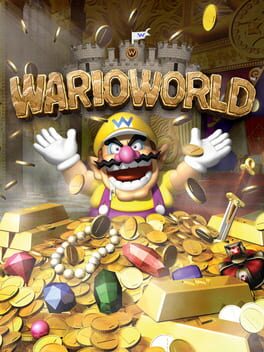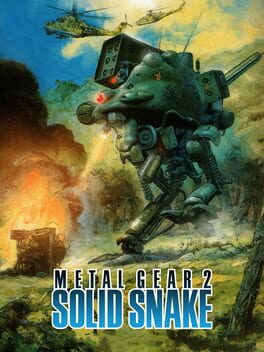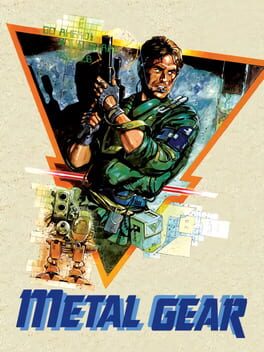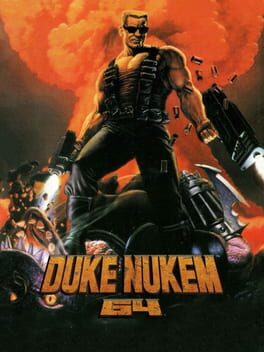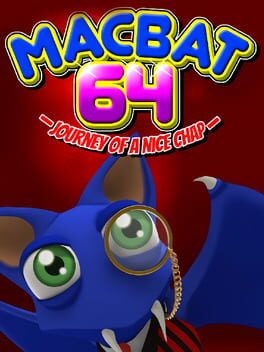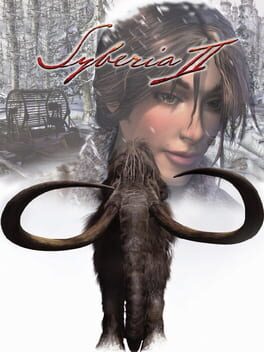SuperGKoopa
BACKER
2003
As a big 3D platformer fan, especially ones with a collect-a-thon theme, Wario World was an exceptionally unique and weird take on the genre I appreciated quite a bit.
One of the main aspects that set this game apart is tying in beat ‘em up mechanics in the platforming levels. Wario doesn’t have nearly as wide of a moveset as Mario when it comes to jumping, but the opportunities to swing and pile-drive enemies around fit the different style of gameplay well. Even when there’s no need for extra coins, it’s just fun hurling a hostile into the group behind you. It also helps that there’s some super creative character design throughout the game. Instead of typical bat, rat, and skeleton enemies, Wario World has everything ranging from flying magnets to vampires in straightjackets to jellyfish shooting lasers. The varied types do a good job at keeping the brawling fresh even when most of them can be defeated by the same attacks.
If you’re not fighting, collecting treasure is the other focus of Wario World. Most of these items are pretty easy to find by just exploring each path of a level, with minimal puzzles or precise jumping required. However, the unusually linear design of each world makes straight backtracking range from tedious to practically impossible. The levels do provide options to loop around to the start of a level after reaching the end, but it’s not quite ideal. If there’s going to be a lot of exploration in a game, putting in so many one-way restrictions creates a weird middle ground where a large part of the discovery is just retracing your steps.
Regardless, Wario World is consistently fun and straightforward enough that it won’t ever get irritating if you’re simply playing to experience every level, as opposed to trying to get 100%. Just don’t spend too long on the pause screen.
One of the main aspects that set this game apart is tying in beat ‘em up mechanics in the platforming levels. Wario doesn’t have nearly as wide of a moveset as Mario when it comes to jumping, but the opportunities to swing and pile-drive enemies around fit the different style of gameplay well. Even when there’s no need for extra coins, it’s just fun hurling a hostile into the group behind you. It also helps that there’s some super creative character design throughout the game. Instead of typical bat, rat, and skeleton enemies, Wario World has everything ranging from flying magnets to vampires in straightjackets to jellyfish shooting lasers. The varied types do a good job at keeping the brawling fresh even when most of them can be defeated by the same attacks.
If you’re not fighting, collecting treasure is the other focus of Wario World. Most of these items are pretty easy to find by just exploring each path of a level, with minimal puzzles or precise jumping required. However, the unusually linear design of each world makes straight backtracking range from tedious to practically impossible. The levels do provide options to loop around to the start of a level after reaching the end, but it’s not quite ideal. If there’s going to be a lot of exploration in a game, putting in so many one-way restrictions creates a weird middle ground where a large part of the discovery is just retracing your steps.
Regardless, Wario World is consistently fun and straightforward enough that it won’t ever get irritating if you’re simply playing to experience every level, as opposed to trying to get 100%. Just don’t spend too long on the pause screen.
1993
When I had previously played Doom, I had a great deal of respect for the historical aspect of the game, but there was something about the graphics that made my eyes sore after just a few minutes. However, I went with the DSDA Doom version instead of the Steam port and that issue went away after I turned off weapon and view bobbing. From there, I had a much more enjoyable experience with the original Doom.
One of the biggest factors that I love about this game is the incredibly fast movement speed. Unlike so many other shooters (especially modern entries in the genre), I was always able to go exactly as fast as I wanted to at anytime. Just as importantly, the controls were also very precise, which lead to some immensely satisfying weaves and strafes through enemy fire. Any damage given or taken was all down to positioning, which I always felt in control of. On top of that, the speedy movement was perfect for navigating the levels. It helped make exploration feel just as fast-paced as the combat, and never made it a slog to cross even the largest rooms.
Another aspect I quickly grew to appreciate this time around is the gruesome visual style. The wide variety of texture definitely helps in keeping a sense of direction, but just as importantly, it perfectly conveys an eerie atmosphere. There were a few instances where I would stop just to admire the macabre environments. I can’t think of any other game that conveys the dread and horror of traversing through hell just as expertly as Doom does.
Part of the Glitchwave Top 100 Project (#100/100)
One of the biggest factors that I love about this game is the incredibly fast movement speed. Unlike so many other shooters (especially modern entries in the genre), I was always able to go exactly as fast as I wanted to at anytime. Just as importantly, the controls were also very precise, which lead to some immensely satisfying weaves and strafes through enemy fire. Any damage given or taken was all down to positioning, which I always felt in control of. On top of that, the speedy movement was perfect for navigating the levels. It helped make exploration feel just as fast-paced as the combat, and never made it a slog to cross even the largest rooms.
Another aspect I quickly grew to appreciate this time around is the gruesome visual style. The wide variety of texture definitely helps in keeping a sense of direction, but just as importantly, it perfectly conveys an eerie atmosphere. There were a few instances where I would stop just to admire the macabre environments. I can’t think of any other game that conveys the dread and horror of traversing through hell just as expertly as Doom does.
Part of the Glitchwave Top 100 Project (#100/100)
1990
After nearly a dozen playthroughs over the years, Super Mario World has remained one of the most consistently fun experiences for me in video gaming. There’s not a single level I would leave out, and the secret exits just make the worlds even more replayable. On top of that, the power-ups are the best of the series, with the cape feather in particular being immensely satisfying to glide, bomb, and dive with. Even obstacles as basic as Koopa shells offer a great variety of options when it comes to kicking and throwing. Everything just fits together so well in offering freedom of control and challenge.
It’s the quintessential idea of what a “perfect game” means to me.
Part of the Glitchwave Top 100 Project (#44/100)
It’s the quintessential idea of what a “perfect game” means to me.
Part of the Glitchwave Top 100 Project (#44/100)
Metal Gear 2 improves on the original Metal Gear in nearly every way. Right from the very beginning of the game, the morality turns gray as NATO engages in a total war campaign against the Outer Heaven nation. The complexity of war is much more apparent throughout, with many characters expressing regrets about their involvements or defecting from their previous alliances. In spite of the heavy themes, the story is well balanced with the regular gameplay, and it never feels like I need to mash buttons to pass the cutscenes.
The 2D Metal Gear gameplay is noticeably upgraded here as well, with the addition of crouching for extra stealth options and the new map grid system to give another layer of strategy when navigating each screen. However, one of the biggest enhancements are the refined boss battles. In the previous game, nearly every boss came down to spamming rockets but in Metal Gear 2 there’s much more variety to their weakness and ideal counters. The final fight in particular is an incredible example of using every single item available to you at its greatest potential.
One of the few areas that holds Metal Gear 2 back is the cryptic nature of a handful of puzzles. Even with the manual as a reference, figuring out how some items are actually meant to be used together gets confusing, especially when it seems like a handful of objects do nothing when equipped. On the other hand, the combat itself can be almost too forgiving at times. Since you keep all your items and fully regain your health when dying, it’s occasionally unsatisfying to not have to survive both journeys of the more intense routes. Regardless of any flaws, Metal Gear 2 is still one of the oldest games you’ll find with both an emotional story and engaging action.
Part of the Glitchwave Top 100 Project (#19/100 - Metal Gear Solid HD Collection)
The 2D Metal Gear gameplay is noticeably upgraded here as well, with the addition of crouching for extra stealth options and the new map grid system to give another layer of strategy when navigating each screen. However, one of the biggest enhancements are the refined boss battles. In the previous game, nearly every boss came down to spamming rockets but in Metal Gear 2 there’s much more variety to their weakness and ideal counters. The final fight in particular is an incredible example of using every single item available to you at its greatest potential.
One of the few areas that holds Metal Gear 2 back is the cryptic nature of a handful of puzzles. Even with the manual as a reference, figuring out how some items are actually meant to be used together gets confusing, especially when it seems like a handful of objects do nothing when equipped. On the other hand, the combat itself can be almost too forgiving at times. Since you keep all your items and fully regain your health when dying, it’s occasionally unsatisfying to not have to survive both journeys of the more intense routes. Regardless of any flaws, Metal Gear 2 is still one of the oldest games you’ll find with both an emotional story and engaging action.
Part of the Glitchwave Top 100 Project (#19/100 - Metal Gear Solid HD Collection)
1988
It’s a great sign when the biggest issue I have with a game is not being able to replay levels. I had previously only beaten Super Mario Bros. 3 by using warp whistles but playing through every world really made me appreciate the huge range of levels, both in terms physical layouts and aesthetic designs. From dodging the Angry Sun to hopping around in the Goomba’s Shoe, it really feels like they squeezed in every possible platforming idea that the team had into a NES cartridge.
Part of the Glitchwave Top 100 Project (#73/100)
Part of the Glitchwave Top 100 Project (#73/100)
1987
As my first Metal Gear game, this was quite an impressive introduction to the series. Compared to games like the original Legend of Zelda, Metal Gear had a few more moments that I would have never gotten past without a walkthrough, but it more than made up for it with the consistently tense stealth-action gameplay and unique puzzles spanning across entire buildings. The segment that really sold me on the game was when it incorporated the trope of NPCs lying to you, but with traps that could be identified by applying your experience gained throughout the game. Even with the limitations of hardware and game mechanics from the mid-80's, the original Metal Gear has the creativity and cleverness that I expected from this series.
Part of the Glitchwave Top 100 Project (#19/100 - Metal Gear Solid HD Collection)
Part of the Glitchwave Top 100 Project (#19/100 - Metal Gear Solid HD Collection)
2022
Woo!
Oh yeah!
Rolling around at the speed of sound
Got places to go
Gotta follow my rainbow
Can't stick around, have to keep movin' on
Guess what lies ahead
Only one way to find out
Must keep on movin' ahead
No time for guessin', follow my plan instead
Trusting in what you can't see
Take my lead, I'll set you free
Follow me, set me free
Trust me and we will escape from the city
I'll make it through, follow me
Follow me, set me free
Trust me and we will escape from the city
I'll make it through, prove it to you
Follow me!
Oh yeah!
Danger is lurking around every turn
Trust your feelings
You've got to live and learn
I know with some luck that I'll make it through
Got no other options
Only one thing to do
I don't care what lies ahead
No time for guessin', follow my plan instead
Find that next stage no matter what that may be
Take my lead, I'll set you free
Follow me, set me free
Trust me and we will escape from the city
I'll make it through, follow me
Follow me, set me free
Trust me and we will escape from the city
I'll make it through, prove it to you
Follow me!
Follow me!
I'll make it through, oh yeah!
Oh yeah!
Rolling around at the speed of sound
Got places to go
Gotta follow my rainbow
Can't stick around, have to keep movin' on
Guess what lies ahead
Only one way to find out
Must keep on movin' ahead
No time for guessin', follow my plan instead
Trusting in what you can't see
Take my lead, I'll set you free
Follow me, set me free
Trust me and we will escape from the city
I'll make it through, follow me
Follow me, set me free
Trust me and we will escape from the city
I'll make it through, prove it to you
Follow me!
Oh yeah!
Danger is lurking around every turn
Trust your feelings
You've got to live and learn
I know with some luck that I'll make it through
Got no other options
Only one thing to do
I don't care what lies ahead
No time for guessin', follow my plan instead
Find that next stage no matter what that may be
Take my lead, I'll set you free
Follow me, set me free
Trust me and we will escape from the city
I'll make it through, follow me
Follow me, set me free
Trust me and we will escape from the city
I'll make it through, prove it to you
Follow me!
Follow me!
I'll make it through, oh yeah!
1997
Really puts the "BOOM" in Boomer Shooter with so much of the game blowing up - the weapons, the enemies, and even the walls of the stage are constantly exploding. The rumble addition for this port is a great touch to add to the destruction, along with some unique weapons like the Expander and Shrinker. A surprisingly appreciated change is the ability to save the captive women too, instead of just killing them like in the original version. It gives a nice pinch of optimism in an otherwise intensely nihilistic game.
1986
This is one of those NES games where the consensus seems to be that it's an interesting historical piece that's almost unplayable from its obscure puzzles. However, the first Legend of Zelda was much more manageable and engaging than I expected for my first full playthrough. The game keeps a great deal of information initially hidden but it all works out well with the focus on exploration. Any mandatory secret rooms or entrances were concealed in ways that were cleverly "hid in plain sight", whether it involved trees that blocked a potential shortcut or dungeon walls that suggested a hidden room when viewing the map. It's a bold move to not make these destructible objects stand out with cracks or a different shade of leaves, but the game gives just enough clues to discover the path forward in the most satisfying way possible. One downside is that once you've done most of your exploring, the last few dungeons recycle so much in terms of enemies, puzzles, and aesthetics. It's almost unfair to compare two games that came out over 30 years apart, but The Breath of the Wild is the entry that really perfected the joy of discovery with all the variety in its world. Despite the open-world blueprint being improved upon so much as gaming as evolved, the original Legend of Zelda is still worth checking out for that unique secret-solving experience.
Part of the Glitchwave Top 100 Project (#70/100 - The Legend of Zelda: Collector's Edition)
Part of the Glitchwave Top 100 Project (#70/100 - The Legend of Zelda: Collector's Edition)
1994
Having now done four playthroughs of Super Metroid (with two of them finishing the full game), it has really grown on me from the first time I attempted it. There are some aspects that still annoy me, like the prevalence of one-way routes (especially in Maridia) and the aiming scheme/weapon management feeling very limited by SNES controls.
However, the parts that I already loved I just appreciate even more now. One of the most consistently excellent examples of this would be the atmosphere. Between the unique wildlife and the diverse soundtrack, all the areas of Zebes stand out perfectly. It really makes the journey across the planet that much more enjoyable, and the distinctive layouts help out immensely in keeping your bearings. Another essential part that makes the exploration so satisfying is the feeling of gradual empowerment. Power-ups are perfectly allocated so that you obtain them not long after noticing barriers or limitations with your current setup. On top of that, all these items have so much more to them than just "keys" to open doors. They also serve as weapons you can use in every battle and upgrades that offer better mobility in traversing the entire world.
It's unusual to see such an early pioneer of a genre still be considered one of the best, but Super Metroid understood from the very beginning how to design an immersive setting and create a sense of accomplishment from exploration.
Part of the Glitchwave Top 100 Project (#20/100)
However, the parts that I already loved I just appreciate even more now. One of the most consistently excellent examples of this would be the atmosphere. Between the unique wildlife and the diverse soundtrack, all the areas of Zebes stand out perfectly. It really makes the journey across the planet that much more enjoyable, and the distinctive layouts help out immensely in keeping your bearings. Another essential part that makes the exploration so satisfying is the feeling of gradual empowerment. Power-ups are perfectly allocated so that you obtain them not long after noticing barriers or limitations with your current setup. On top of that, all these items have so much more to them than just "keys" to open doors. They also serve as weapons you can use in every battle and upgrades that offer better mobility in traversing the entire world.
It's unusual to see such an early pioneer of a genre still be considered one of the best, but Super Metroid understood from the very beginning how to design an immersive setting and create a sense of accomplishment from exploration.
Part of the Glitchwave Top 100 Project (#20/100)
This review contains spoilers
As both a huge fan of 3D platformers and the N64, Macbat 64 feels so perfectly designed to my tastes. The compact levels are all just so pleasant to explore and would fit well as bonus rooms in Banjo-Kazooie. The low-poly look is also a great style, and something that is massively underutilized in indie games.
However, the greatest feature of MacBat 64 for me would be how the game encourages boundary breaking. 3D games of the 5th generation always had such a simple and overt way of setting the edges of environments, and it often felt like the game was enticing the player to move beyond the level's limits. The stages in Macbat 64 all perfectly carry on that vibe and later on you even get the tools to overcome invisible walls. The extra rooms and secrets hidden outside the main world are such an incredible addition, and it's heartwarming to know that someone else experienced those same mysteries when playing the 3D classics.
However, the greatest feature of MacBat 64 for me would be how the game encourages boundary breaking. 3D games of the 5th generation always had such a simple and overt way of setting the edges of environments, and it often felt like the game was enticing the player to move beyond the level's limits. The stages in Macbat 64 all perfectly carry on that vibe and later on you even get the tools to overcome invisible walls. The extra rooms and secrets hidden outside the main world are such an incredible addition, and it's heartwarming to know that someone else experienced those same mysteries when playing the 3D classics.
2022
2022
As a cartography fan I totally appreciate the concept, but even with the rotation setting a majority of the countries can be identified very quickly. I’d love to the entry pool open up to include country subdivisions as a potential hard mode. In addition, making the outlines start out as greatly simplified and become more precise with each guess might fit the boundary theme better than just distance estimates.
2004
Syberia II dives into the mystical aspects hinted at in the original game, and the stranger settings and cast make for an even more creative story. It's still a very linear and occasionally glitchy adventure, but the dialogue and atmosphere is just as entrancing as before. However, the puzzles aren't quite as refined and feel more trial-and-error based. There were a few that I legitimately solved on accident and I'm still not sure how the game wanted me to discover the pattern or code. Regardless, it's an essential and satisfactory entry if you have the slightest investment in the characters Kate Walker, Oscar, and Hans Voralberg.
